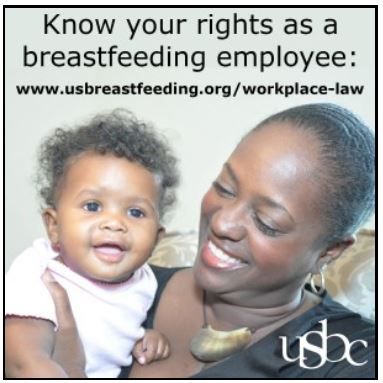By Kim Cierpik-Gold
Returning to work following the birth of a child can be an emotional transition, which is particularly hard on a person who is also navigating breastfeeding and expressing milk while separated from the baby. Laws are in place to support breastfeeding persons in the workplace, and knowing your rights is an important step in discussing pumping breaks with employers or supervisors.
The Fair Labor Standards Act (FLSA) of 1938 establishes federal laws employers must follow. Section 7 (29 U.S.C. 207), added in 2010, provides accommodations for one year following the birth of a child and includes direction for providing sufficient time and private space that is not a bathroom to express milk.
Specifically, the amended Section 7 of the Fair Labor Standards Act of 1938 (29 U.S.C. 207) provides a nursing employee:
- a reasonable break time for an employee to express breast milk for her nursing child for 1 year after the child’s birth each time such employee has need to express the milk;
- a place, other than a bathroom, that is shielded from view and free from intrusion from coworkers and the public, which may be used by an employee to express breast milk. 2
If state law provides greater protections, then the state law should be followed. For example, the State of Colorado provides the same requirements for reasonable break time and a private place; however, Colorado state law is effective for two years following the birth. For employees working in Colorado, their protection exceeds the federal standard.
Thirty-two states, the District of Columbia and Puerto Rico have laws related to breastfeeding in the workplace. (Arkansas, California, Colorado, Connecticut, Delaware, Georgia, Hawaii, Illinois, Indiana, Kentucky, Louisiana, Maine, Maryland, Massachusetts, Minnesota, Mississippi, Montana, New Jersey, New Mexico, New York, North Dakota, Oklahoma, Oregon, Rhode Island, South Carolina, Tennessee, Texas, Utah, Vermont, Virginia, Washington and Wyoming.) 8
Companies with fewer than 50 employees are excluded from The Fair Labor Standards Act Section 7 provision as it could cause undue hardship for the employer. For employees who are either not covered through FLSA Section 7, there are options! State laws might offer protection even if the federal law does not apply. To see specifics of your state legislation for expressing in the workplace, search the National Conference of State Laws for state provisions.
Local breastfeeding coalitions and your state’s department of labor may provide support with helping breastfeeding parents work with their smaller companies to allow for suitable expressing break accommodations, and with modifying small spaces to accommodate the expressing of milk safely and in privacy. To help make your case stronger, check out the resources on The Business Case for Breastfeeding, a comprehensive program designed to educate employers about the value of supporting breastfeeding employees in the workplace. 4
Resources:
- US Department of Health and Human Services. Office on Women’s Health. What the law says about breastfeeding and work
- United States Department of Labor: Section 7(r) of the Fair Labor Standards Act – Break Time for Nursing Mothers Provision
- Fact Sheet #73: Break Time for Nursing Mothers
- US Dept. of Health and Human Services. Office on Women’s Health: The Business Case for Breastfeeding
- Directory of US Breastfeeding Coalitions
- US Breastfeeding Committee: Workplace Support in Federal Law
- US Department of Labor: Frequently Asked Questions – Break Time for Nursing Mothers
- National Conference on State Legislators: Breastfeeding State Laws
- Receso para Madres que Amamantan: bajo la Ley de Normas Justas de Trabajo (FLSA)
- Office on Women’s Health: What employers need to know
Kim Cierpik-Gold
© 2020 Breastfeeding USA, all rights are reserved.

